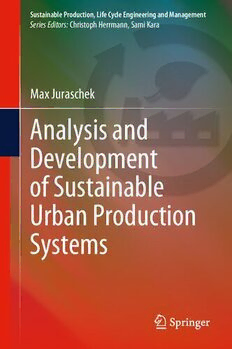
Analysis and Development of Sustainable Urban Production Systems PDF
Preview Analysis and Development of Sustainable Urban Production Systems
Sustainable Production, Life Cycle Engineering and Management Series Editors: Christoph Herrmann, Sami Kara Max Juraschek Analysis and Development of Sustainable Urban Production Systems Sustainable Production, Life Cycle Engineering and Management SeriesEditors ChristophHerrmann,Braunschweig,Germany SamiKara,Sydney,Australia SPLCEM publishes authored conference proceedings, contributed volumes and authoredmonographsthatpresentcutting-edgeresearchinformationaswellasnew perspectives on classical fields, while maintaining Springer’s high standards of excellence,thecontentispeerreviewed.Thisseriesfocusesontheissuesandlatest developments towards sustainability in production based on life cycle thinking. Modern production enables a high standard of living worldwide through products and services. Global responsibility requires a comprehensive integration of sustainable development fostered by new paradigms, innovative technologies, methods and tools as well as business models. Minimizing material and energy usage, adapting material and energy flows to better fit natural process capacities, and changing consumption behaviour are important aspects of future production. A life cycle perspective and an integrated economic, ecological and social evaluationareessentialrequirementsinmanagementandengineering. **IndexedinScopus** To submit a proposal or request further information, please use the PDF Proposal Form or contact directly: Petra Jantzen, Applied Sciences Editorial, email:[email protected] Moreinformationaboutthisseriesathttp://www.springer.com/series/10615 Max Juraschek Analysis and Development of Sustainable Urban Production Systems MaxJuraschek InstituteofMachineToolsandProduction Technology TechnischeUniversitätBraunschweig Braunschweig,Germany ISSN2194-0541 ISSN2194-055X (electronic) SustainableProduction,LifeCycleEngineeringandManagement ISBN978-3-030-76601-6 ISBN978-3-030-76602-3 (eBook) https://doi.org/10.1007/978-3-030-76602-3 ©TheEditor(s)(ifapplicable)andTheAuthor(s),underexclusivelicensetoSpringerNature SwitzerlandAG2022 Thisworkissubjecttocopyright.AllrightsaresolelyandexclusivelylicensedbythePublisher,whether thewholeorpartofthematerialisconcerned,specificallytherightsoftranslation,reprinting,reuse ofillustrations,recitation,broadcasting,reproductiononmicrofilmsorinanyotherphysicalway,and transmissionorinformationstorageandretrieval,electronicadaptation,computersoftware,orbysimilar ordissimilarmethodologynowknownorhereafterdeveloped. Theuseofgeneraldescriptivenames,registerednames,trademarks,servicemarks,etc.inthispublication doesnotimply,evenintheabsenceofaspecificstatement,thatsuchnamesareexemptfromtherelevant protectivelawsandregulationsandthereforefreeforgeneraluse. Thepublisher,theauthorsandtheeditorsaresafetoassumethattheadviceandinformationinthisbook arebelievedtobetrueandaccurateatthedateofpublication.Neitherthepublishernortheauthorsor theeditorsgiveawarranty,expressedorimplied,withrespecttothematerialcontainedhereinorforany errorsoromissionsthatmayhavebeenmade.Thepublisherremainsneutralwithregardtojurisdictional claimsinpublishedmapsandinstitutionalaffiliations. ThisSpringerimprintispublishedbytheregisteredcompanySpringerNatureSwitzerlandAG Theregisteredcompanyaddressis:Gewerbestrasse11,6330Cham,Switzerland Preface Themanufacturingofproductsinurbanproductionsitesisconnectedtouniquepoten- tials,yetalsotospecificchallenges.Urbanfactoriescanprovidefunctionaldiversity andcontributepositiveimpactstoacity.Theconceptofurbanproductionreceives risingattentioninresearchandindustryanditisrecognizedinitsinterdisciplinary nature.Aholisticapproach isrequiredforboththeurbanandthefactoryperspec- tive to minimize negative impacts, enable positive effects and to create mutually beneficial,symbioticcombinations. Whilepromotingtheconceptoflocalproductionfromlocalresourcesforlocal consumption,theconceptofsustainableurbanproductionshouldnotbeunderstood as backward facing and oriented at historic small-scale craft production. It rather advocatestheutilizationofmodernproductiontechnologyandmethodstoimplement moredecentralizedapproachesforvaluecreationthroughtheproductionofgoods. ThisbookwaswritteninthecontextofmyworkattheInstituteofMachineTools and Production Technology (IWF) at Technische Universität Braunschweig. I am mostgratefulfortheopenandproductiveworkingenvironmentandtheinvaluable supportofProf.Dr.-Ing.ChristophHerrmann.Furthermore,Iwouldliketoacknowl- edge and express my gratitude toProf.Vanessa Carlow (TUBraunschweig), Prof. Sami Kara (University of New South Wales), Prof. Dr.-Ing. Thomas Vietor (TU Braunschweig)andProf.Dr.-Ing.SebastianThiede(UniversityofTwente)fortheir support and fruitful discussions. And of course, a big thank you goes out to all colleaguesandfriendsIhadthepleasuretomeetandcollaboratewithonthetopic ofsustainableurbanproductionandbeyond. Braunschweig,Germany MaxJuraschek v Summary This book provides a framework for the analysis and development of sustainable urbanproductionsystems.Basedonaliteraturereviewassessingthecurrentstateof thistopic,acomprehensivemodelontheexchangerelationsbetweentheurbanand thefactorysystemisestablished.Theproposedurbanfactorysystemmodeldescribes theinterdependenciesandinfluencesofthefactorysystemandtheurbansystemon eachotherviaconnectingvariablesthataredeterminedbythecity–factoryinterface. From activities in each system, exchange flows originate, which are subsequently crossing the interface and leading to positive or negative impacts on the available urbanresources.Astructuredclassificationofexchangeflowsderivedfromthefunc- tional analysis of the layers of a generalized factory system provides an overview of potential interactions between the city and the factory system. Subsequently, theformulatedimpactquantificationmethodenablesdecisionsupportmechanisms. Urbanfactoriesprovidethecapabilitiesfortheprovisionofurbanfunctions,as,for instance,innovation,education,recreationandvaluecreation.Thetargetedutiliza- tionofthispotentialcansupporttheperformanceofanurbansystembyfunctional integration.Aproductlifecyclestageperspectiveforproductionsitesandservices isapromisingstartingpoint. Thefundamentalprinciplesofexchangeflowsandimpactassessmentprovidean operationalization of the urban factory system model, allowing the derivation and evaluationoftheeffectsofurbanproductiononurbansystems.Withtheestablish- ment of a reference system and the methodology of exchange flows, the impacts ofactivitiesandprocessesofproductionsitesintheurbansystemcanbeevaluated, suitableimprovementmeasuresandtheirexpectedeffectsidentifiedandfuturedevel- opmentscenariosdesigned.Forimplementation,aselectionofapplicablemethods is presented, structured by their spatial scope, the intended application stage and the addressed stakeholder. The application of the urban factory system model and the impact assessment method in two case studies on an urban craft brewery and the urban production of eyeglass frames illustratesthe feasibilityof the developed concept.Inthecasestudies,itbecameapparentthatdistributed,localizedandsmall urbanproductionsystemscanprovidespecificservicesforcities. vii viii Summary Thedevelopedframeworkandmethodsfortheevaluationandimplementationof sustainableurbanproductionsystemsenabletheassessmentofimpactsandprovide themeanstocontrolandutilizetheuniquestrengthsofurbanfactoriesforcitiesand industries.Thiswillallowastructuredderivationofmethodsandmeasuresfromthe conceptofurbanproductionforproducingenterprisesandtheurbanstakeholders. Contents 1 IntroductionandMotivation .................................... 1 References ..................................................... 5 2 Urban Space, Production Systems and Sustainable Development ................................................... 7 2.1 UrbanSpace ............................................... 7 2.1.1 CitiesandtheDefinitionofUrbanSpace ................ 8 2.1.2 FunctionalPerspectiveonUrbanSpace ................. 11 2.1.3 UrbanStakeholdersandPlanningProcesses .............. 13 2.2 ProductionSystems ......................................... 15 2.2.1 LocationDecisionsofManufacturingCompanies ......... 17 2.2.2 Manufacturing Paradigms and Decentralized Manufacturing ....................................... 18 2.3 SustainableDevelopment .................................... 20 2.3.1 SustainableUrbanDevelopment ....................... 22 2.3.2 SustainableProductionSystems ........................ 25 2.4 UrbanProductionSystems ................................... 27 2.4.1 SelectedExamplesofUrbanFactories .................. 29 2.4.2 ResearchQuestionsforSustainableUrbanProduction Systems ............................................ 33 References ..................................................... 34 3 ExistingApproachesforUrbanProductionSystems ............... 39 3.1 FindingsfromtheStructuredLiteratureSearch ................. 39 3.1.1 ClassificationoftheStateofResearch ................... 41 3.1.2 LiteratureAddressing Specific Aspects of Urban Production .......................................... 43 3.2 EvaluationoftheStateofResearchonUrbanProduction Systems ................................................... 45 3.2.1 ResearchApproach ................................... 48 3.2.2 Perspective .......................................... 50 3.2.3 SpatialScope ........................................ 52 3.2.4 Improvement ........................................ 54 ix x Contents 3.2.5 Focus .............................................. 55 3.3 DerivationofResearchDemand .............................. 57 References ..................................................... 58 4 Integrated Concept for Analysis and Development ofSustainableUrbanProductionSystems ........................ 63 4.1 DesignofanIntegratedConceptTowardsSustainableUrban ProductionSystems ......................................... 64 4.1.1 Requirements ....................................... 64 4.1.2 IntegratedConceptforAnalysisandDevelopment ofSustainableUrbanProductionSystems ............... 65 4.1.3 SystemBoundaryandUrbanResources ................. 66 4.2 UrbanFactorySystemModel ................................ 69 4.2.1 SystemPerspectiveonFactoriesandUrbanSpace ........ 70 4.2.2 TheCity-Factory-Interface ............................ 71 4.2.3 UrbanFactoryExchangeFlowModel ................... 73 4.3 ModelApplicationFramework ............................... 75 4.3.1 QualificationandQuantificationofExchangeFlows ...... 76 4.3.2 ImpactAssessment ................................... 77 4.3.3 AnalysisBasedonExchangeFlows ..................... 85 4.3.4 DecisionSupport .................................... 86 4.4 MethodsforImplementation ................................. 87 4.4.1 ThePlanningProcessofUrbanProductionSystems ....... 88 4.4.2 SelectedMethodsforImplementationofSustainable UrbanProductionSystems ............................ 89 References ..................................................... 112 5 ApplicationoftheIntegratedConceptforSustainableUrban ProductionSystems ............................................ 115 5.1 CaseStudy:UrbanMicroBrewery ............................ 115 5.1.1 SpatialConditionsandSystemBoundaries .............. 116 5.1.2 ExchangeFlowsandImpactAssessment ................ 119 5.1.3 UrbanIntegrationandUrbanFactoryServices ............ 121 5.1.4 Analysis ............................................ 128 5.2 CaseStudy:UrbanProductionofEyeglassFrames .............. 130 5.2.1 SpatialConditionsandSystemBoundaries .............. 131 5.2.2 UrbanProductLifeCycleAssessment .................. 132 5.2.3 ProductLifeCycleStageAssessment ................... 134 5.2.4 Analysis ............................................ 136 References ..................................................... 137 6 Summary,CurrentChallengesandFutureResearchDirections ..... 139 6.1 AnalysisandDevelopmentofSustainableUrbanProduction Systems ................................................... 140 6.2 CurrentChallenges ......................................... 142 6.3 FutureResearchDirections .................................. 144
